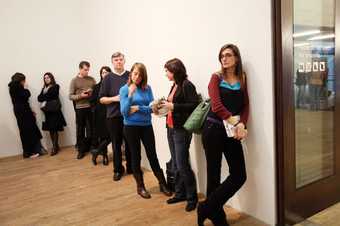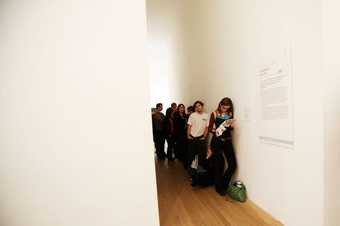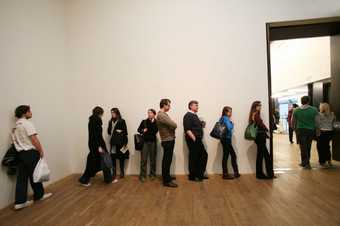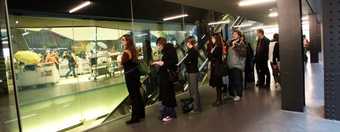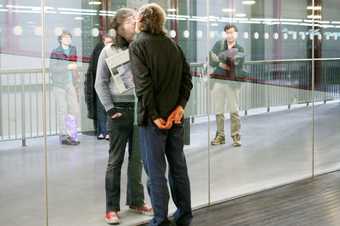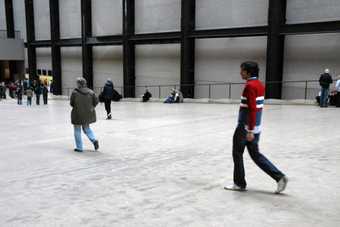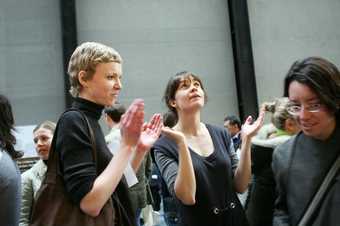Good Feelings in Good Times 2007 (Tate T11940) is a performance work by the artist Roman Ondák comprising a line of people, queuing for nothing. For this iteration, as part of UBS Openings: Saturday Live – Actions and Interruptions at Tate Modern, ten people in two shifts formed queues in different sites through the building.
The queue lined up at strange or insignificant places, such as in front of a wall, or by a fire exit – spaces that the museum public would not be particularly aware of but not somewhere absurd, such as the corner of a room. The group was made up of volunteers and professional actors, and Ondák distributed instructions before the performance barring participants from divulging anything about the performance while it took place. ‘Non-acting’ was the most significant instruction given, by which Ondák meant dressing and behaving in a manner in-keeping with the context. That included wearing the clothes one would ordinarily wear to visit a museum and using personal items such as handbags, mobile phones and reading material to pass the time. If members of the public joined in or asked what the group were waiting for, the performers had to give uniform responses, such as ‘we’re just queuing’, or ‘I don’t know’.
Ondák explained that ‘the queue should not be put on a pedestal or isolated from the everyday milling about that is typical for an art fair or a gallery, i.e. there should be enough audience around for the queue to blend in’.1 Ondák wanted members of the public to perhaps read about it the next day, or to talk and hypothesise among themselves, forcing them to make connections between what they have seen and been told. The queues formed and dissolved quite rapidly, lasting three to five minutes at any one location. The actors had to be aware of their environment, making sure to take longer breaks if the space was particularly empty, so as not to be too conspicuous. For the same reason, the performers never walked from one location to the next as a group. A ‘head’ of the queue was nominated: ‘He or she starts at one of the agreed locations, then two more join, then another two, etc. After a short while the person at the back of the queue leaves first, then the next, and so on. The queue forms and disperses gradually.’2
Good Feelings in Good Times subtly interrupted the museum space through choreographed everyday behaviour, responding to the Actions and Interruptions programme of which it was part. The programme sought to investigate Tate Modern as an environment that operates as both a public space and as a fine art museum. The artworks featured eschewed traditional staging, set times and direct spectatorship, often eliciting reactions from visitors or framing people’s habitual use of the space rather than focusing on the artworks on display. Ondák’s instructions acted as such a framing device, separating one group from another and so establishing a different encounter with art in the gallery. Good Feelings for Good Times was first performed in 2003 at the Kölnischer Kunstverein in Cologne and again at Frieze Art Fair in London in 2004. The work was then acquired for the Tate collection. It can be re-enacted either indoors, with a minimum of seven and a maximum of twelve people, or outdoors with a maximum of fifteen people.
Philomena Epps
February 2016

